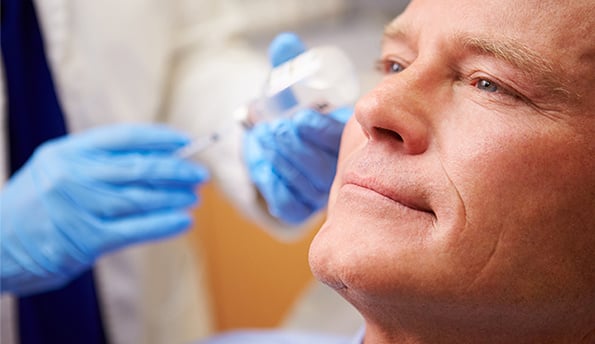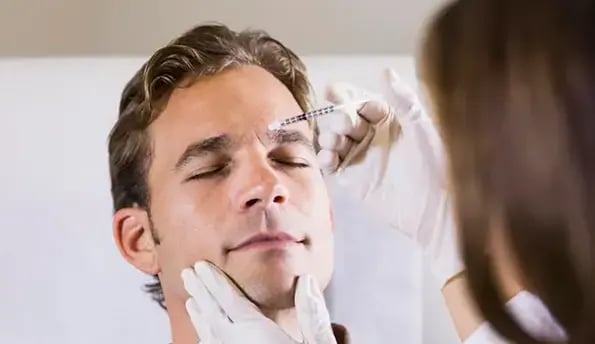The Guys Guide to Botox
Men's Essential Guide to Botox
Botox is often used by men on areas like between the eyebrows, forehead, jaw muscles for teeth grinding and jawline, around the eyes, and chin for smoothing or defining.
Botox is approved for people 18 and older, but experts recommend waiting until your mid-20s to early 30s. It’s usually not needed before then unless you have strong wrinkles affecting your confidence or a medical issue like teeth grinding or migraines that Botox can help with.

It Only Takes a Few Minutes
Getting Botox is quick and doesn’t need anesthesia. A doctor can inject it in just a few minutes.
Prices for Botox vary widely based on where you are, the doctor’s experience, and how much is used. Expect to pay at least a couple hundred dollars to ensure quality. Cheaper options might mean less experienced providers. Botox effects last around four months.
The “Tox” in Botox is Short for Toxin
Botox isn't the only product that reduces wrinkles. While Botox is popular, some people become resistant to it over time. They can try other options like Xeomin or Dysport, which work similarly to Botox but with some differences. Xeomin is a pure botulinum toxin and may cause fewer allergic reactions. Dysport spreads more easily, making it good for larger areas like the forehead.
Botox isn't the same as fillers, like Restylane or Juvederm, which add volume to the face. Botox relaxes muscles to smooth wrinkles, while fillers plump up wrinkles using substances like hyaluronic acid. If someone suddenly has fuller lips or cheeks, they likely have fillers. Smooth, wrinkle-free foreheads often mean Botox was used.
Fillers usually last longer than Botox, from six months to 18 months, and both can be used together for a youthful look.
Our mission is to create a world where every investment in modern beauty is Worth It.
Let's keep in touch
Get updates of the treatments you are interested
Botox Works by Blocking Muscle Contractions
Botox works by injecting a neurotoxin into muscles, blocking nerve signals that cause contractions. This process relaxes the muscles, smoothing out wrinkles and lines on the face. It's commonly used between the eyebrows, on the forehead, and around the eyes to achieve a more youthful appearance.
Although temporary, typically lasting around four months, Botox treatments are popular for their quick procedure time and effectiveness in reducing signs of aging. It's important to consult with a qualified medical professional to determine if Botox is suitable for your cosmetic goals and health conditions, as results and risks can vary.
Who Should Consider Botox—And Who Should Not
Botox is suitable for adults looking to reduce facial wrinkles caused by muscle contractions, such as frown lines and crow's feet. It's ideal for those bothered by these lines and seeking a temporary solution. However, individuals under 18, pregnant women, and those with certain neuromuscular disorders or allergies to botulinum toxin should avoid Botox.
Consulting with a qualified healthcare provider is crucial to ensure safety and suitability for treatment. They can assess your individual health and cosmetic concerns to determine if Botox is right for you. Understanding the risks and benefits is essential before proceeding with treatment.

Botox Is Not The Only Product Like This On the Market
Botox isn't the only option for reducing wrinkles. Other products, such as Xeomin and Dysport, also use botulinum toxin to achieve similar results. Xeomin offers comparable benefits to Botox, including smoothing out forehead lines and crow's feet, with a potentially lower risk of allergic reactions. Dysport, on the other hand, spreads more widely and is suitable for larger areas like the forehead.
It's important to discuss with a qualified healthcare provider to choose the best treatment based on your needs and preferences. Each product has its characteristics and considerations, so understanding these differences is key.
Botox Is Not the Same Thing as Fillers, Another Common Procedure
Botox and fillers are different treatments for reducing wrinkles. Botox works by relaxing muscles to smooth lines caused by facial expressions, like frown lines and crow's feet. Fillers, such as Restylane and Juvederm, add volume to areas with deeper wrinkles or lost volume, like cheeks and lips, using substances like hyaluronic acid.
Botox results typically last around four months, while fillers can last from several months to over a year. Both treatments can be combined for comprehensive facial rejuvenation. It's essential to consult with a qualified healthcare provider to decide which treatment best meets your aesthetic goals.
Our mission is to create a world where every investment in modern beauty is Worth It.
Let's keep in touch
Get updates of the treatments you are interested
Preparing for Botox (Before and After the Injection)
Preparing for Botox involves a few simple steps. Before the injection, avoid blood-thinning medications like aspirin to reduce bruising. Afterward, avoid rubbing the treated areas for several hours to prevent the spreading of the toxin. You may experience mild swelling or redness at the injection sites, which usually subsides quickly.
Refrain from vigorous exercise and alcohol for the first day to ensure the best results. Follow any specific instructions from your healthcare provider for optimal recovery and effectiveness. Always discuss any concerns or questions you have about the procedure with your healthcare provider before and after the treatment.
Men's Essential Guide to Botox
Botox is often used by men on areas like between the eyebrows, forehead, jaw muscles for teeth grinding and jawline, around the eyes, and chin for smoothing or defining.
Botox is approved for people 18 and older, but experts recommend waiting until your mid-20s to early 30s. It’s usually not needed before then unless you have strong wrinkles affecting your confidence or a medical issue like teeth grinding or migraines that Botox can help with.

It Only Takes a Few Minutes
Getting Botox is quick and doesn’t need anesthesia. A doctor can inject it in just a few minutes.
Prices for Botox vary widely based on where you are, the doctor’s experience, and how much is used. Expect to pay at least a couple hundred dollars to ensure quality. Cheaper options might mean less experienced providers. Botox effects last around four months.
The “Tox” in Botox is Short for Toxin
Botox isn't the only product that reduces wrinkles. While Botox is popular, some people become resistant to it over time. They can try other options like Xeomin or Dysport, which work similarly to Botox but with some differences. Xeomin is a pure botulinum toxin and may cause fewer allergic reactions. Dysport spreads more easily, making it good for larger areas like the forehead.
Botox isn't the same as fillers, like Restylane or Juvederm, which add volume to the face. Botox relaxes muscles to smooth wrinkles, while fillers plump up wrinkles using substances like hyaluronic acid. If someone suddenly has fuller lips or cheeks, they likely have fillers. Smooth, wrinkle-free foreheads often mean Botox was used.
Fillers usually last longer than Botox, from six months to 18 months, and both can be used together for a youthful look.
Our mission is to create a world where every investment in modern beauty is Worth It.
Let's keep in touch
Get updates of the treatments you are interested
Botox Works by Blocking Muscle Contractions
Botox works by injecting a neurotoxin into muscles, blocking nerve signals that cause contractions. This process relaxes the muscles, smoothing out wrinkles and lines on the face. It's commonly used between the eyebrows, on the forehead, and around the eyes to achieve a more youthful appearance.
Although temporary, typically lasting around four months, Botox treatments are popular for their quick procedure time and effectiveness in reducing signs of aging. It's important to consult with a qualified medical professional to determine if Botox is suitable for your cosmetic goals and health conditions, as results and risks can vary.
Who Should Consider Botox—And Who Should Not
Botox is suitable for adults looking to reduce facial wrinkles caused by muscle contractions, such as frown lines and crow's feet. It's ideal for those bothered by these lines and seeking a temporary solution. However, individuals under 18, pregnant women, and those with certain neuromuscular disorders or allergies to botulinum toxin should avoid Botox.
Consulting with a qualified healthcare provider is crucial to ensure safety and suitability for treatment. They can assess your individual health and cosmetic concerns to determine if Botox is right for you. Understanding the risks and benefits is essential before proceeding with treatment.

Botox Is Not The Only Product Like This On the Market
Botox isn't the only option for reducing wrinkles. Other products, such as Xeomin and Dysport, also use botulinum toxin to achieve similar results. Xeomin offers comparable benefits to Botox, including smoothing out forehead lines and crow's feet, with a potentially lower risk of allergic reactions. Dysport, on the other hand, spreads more widely and is suitable for larger areas like the forehead.
It's important to discuss with a qualified healthcare provider to choose the best treatment based on your needs and preferences. Each product has its characteristics and considerations, so understanding these differences is key.
Botox Is Not the Same Thing as Fillers, Another Common Procedure
Botox and fillers are different treatments for reducing wrinkles. Botox works by relaxing muscles to smooth lines caused by facial expressions, like frown lines and crow's feet. Fillers, such as Restylane and Juvederm, add volume to areas with deeper wrinkles or lost volume, like cheeks and lips, using substances like hyaluronic acid.
Botox results typically last around four months, while fillers can last from several months to over a year. Both treatments can be combined for comprehensive facial rejuvenation. It's essential to consult with a qualified healthcare provider to decide which treatment best meets your aesthetic goals.
Our mission is to create a world where every investment in modern beauty is Worth It.
Let's keep in touch
Get updates of the treatments you are interested
Preparing for Botox (Before and After the Injection)
Preparing for Botox involves a few simple steps. Before the injection, avoid blood-thinning medications like aspirin to reduce bruising. Afterward, avoid rubbing the treated areas for several hours to prevent the spreading of the toxin. You may experience mild swelling or redness at the injection sites, which usually subsides quickly.
Refrain from vigorous exercise and alcohol for the first day to ensure the best results. Follow any specific instructions from your healthcare provider for optimal recovery and effectiveness. Always discuss any concerns or questions you have about the procedure with your healthcare provider before and after the treatment.




.webp?width=200&height=200&name=thread-lift%20(1).webp)

